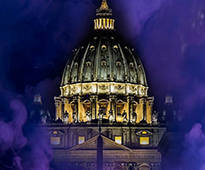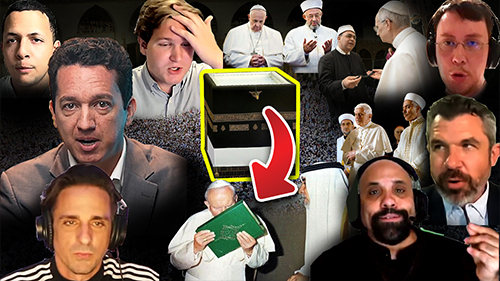| Recent Featured Videos and Articles | Eastern “Orthodoxy” Refuted | How To Avoid Sin | The Antichrist Identified! | What Fake Christians Get Wrong About Ephesians | Why So Many Can't Believe | “Magicians” Prove A Spiritual World Exists | Amazing Evidence For God | News Links |
| Vatican II “Catholic” Church Exposed | Steps To Convert | Outside The Church There Is No Salvation | E-Exchanges | The Holy Rosary | Padre Pio | Traditional Catholic Issues And Groups | Help Save Souls: Donate |  |









 " />
" /> " />
" /> " />
" /> " />
" /> " />
" />




Objection 6): Vatican I’s definitions on the perpetuity of the Papal Office contradict the claims of the sedevacantists.
Answer: Vatican I’s dogmas don’t contradict a vacancy of the Papal See; in fact, it’s only those who reject the Vatican II antipopes who can consistently accept these papal dogmas, since Benedict XVI utterly rejects them.
ANSWERS TO SPECIFIC PASSAGES FROM VATICAN I CITED BY NONSEDEVACANTISTS – AND THE ABSURDITY OF A “POPE” WHO DOESN’T BELIEVE IN VATICAN I
People attempting to refute sedevacantism often cite three passages from Vatican I. We will specifically address all three of those passages. Before we do that, we must emphasize the fact we just discussed: there have been long periods of time when the Church has had no pope. We’ve already mentioned the three and a half year interregnum between Pope St. Marcellinus and Pope St. Marcellus.
Although Pope St. Gregory VII died on May 25, 1085, it was not until almost two years later - May 9, 1087 - that his successor, Pope Victor III, was elected. On June 25, 1243, Pope Innocent IV became the 179th successor to St. Peter; his immediate predecessor, Pope Celestine IV, however, had died over a year and a half before - November 10, 1241. Later in the same century, Catholics would be forced to wait nearly three years as the Church, upon the death of Pope Clement IV on November 29, 1268, delayed naming a new Pope until St. Gregory X was picked on September 1, 1271. Other examples of a year or more space between popes can be cited, the point here being that while the quick transfer of papal power has been common, exceptions are to be found. Today’s crisis, then, certainly is not the first time in which the Church has suffered for a significant period of time without a pope.
We’ve already discussed antipopes who reigned from Rome while posing as the pope, something we saw in the case of Anacletus II and the Great Western Schism. There is also a theological axiom, “plus or minus does not mutate the species, a change in degree does not affect the principle.” If the Church did not defect or lose perpetual papal succession during a 3 year and 7 month vacancy, then the Church will not defect or lose perpetual papal succession during a 40 year vacancy. The principle is the same, unless one can cite a specific teaching of the Church which declares a limit to a papal interregnum.
Since there is no teaching which puts a limit on such a papal interregnum (a period without a pope), and since the definitions of Vatican I on the perpetuity of Papal Office make absolutely no mention of papal vacancies or how long they can last, if the definitions of Vatican I disprove the sedevacantist position (as some claim), then they also disprove the indefectibility of the Catholic Church – every single time the Church finds itself without a pope. But this is impossible and ridiculous, of course.
Thus, in order to be consistent, non-sedevacantists who quote Vatican I against the sedevacantist “thesis” must argue that the Church can never be without a pope, not even for a moment (a patent absurdity). But this is exactly what one of them argued in a very interesting slip-up in an article. This serves to reveal his profound bias and the errors at the heart of his position:
This is obviously absurd and completely false. The writer knows that this is false because, in the next sentence, he declares:
First, the interregnum he mentions was not the longest in Church history (as we saw above). Second, he admits that the Church existed without a pope for years. So there have been quite a few “moments” in Church history that the Church has been without a pope. Why would he say that the Church cannot be without a pope “even for a moment” when he knows that this is not true?
Now that the fact that the Church can be without a pope for a long period of time has been established, let’s look at the passages of Vatican I:
That what Christ instituted in St. Peter (THE OFFICE OF PETER) remains the perpetual principle and visible foundation of unity EVEN TODAY, AND WHEN THERE IS NO POPE, is proven every time a Catholic who is a sedevacantist converts an Eastern “Orthodox” Schismatic to the Catholic Faith.
The Catholic (who is a sedevacantist) charitably informs the Eastern Schismatic that he (the Eastern Schismatic) is not in the unity of the Church because he doesn’t accept what Christ instituted in St. Peter (the office of the Papacy), in addition to not accepting what the successors of St. Peter have bindingly taught in history (the Council of Trent, etc.). This is a clear example of how the Office of the Papacy still serves – and will always serve – as the perpetual principle of visible unity, distinguishing the true faithful from the false (and the true Church from the false). This is true when there is no pope, and for the sedevacantist today. This dogmatic teaching of Vatican I doesn’t exclude periods without a pope and it is not contrary to the sedevacantist thesis in any way.
In fact, while this definition remains true for the sedevacantist, it must be stated clearly that THIS DEFINITION OF VATICAN I ONLY REMAINS TRUE FOR THE SEDEVACANTIST. THIS DEFINITION OF VATICAN I ON THE PAPACY BEING THE PERPETUAL PRINCIPLE AND VISIBLE FOUNDATION OF UNITY IS MOST CERTAINLY NOT TRUE FOR THOSE UNDER BENEDICT XVI. This teaching of Vatican I only remains true for the sedevacantist (not those under Benedict XVI) because Vatican II teaches just the opposite:
We see that Vatican II teaches that the Papacy is not the visible foundation of the unities of faith and communion. It teaches that those who reject the Papacy are in communion with the Church. Since this is the official teaching of the Vatican II sect and its antipopes, those who adhere to them contradict the above teaching of Vatican I.
Second, the teaching of Vatican I on the perpetuity of the Papal Office only remains true for the sedevacantist because Benedict XVI explicitly teaches that accepting the Papacy is not essential for unity!
We’ve already shown – but it was necessary to quote it again here – that Benedict XVI specifically mentions, and then bluntly rejects, the traditional teaching of the Catholic Church that the Protestants and Eastern Schismatics must be converted to the Catholic Faith and accept Vatican I (“the full scope of the definition of 1870”) for unity and salvation. He specifically rejects that the dogmatic definition of Vatican I (accepting the Papacy, etc.) is binding for Church unity. Besides the fact that this is another clear example of manifest heresy from the Vatican II antipopes, this proves that BENEDICT XVI (THE MAN THEY ACTUALLY CLAIM IS THE “POPE”) DENIES THE VERY DOGMA FROM VATICAN I THAT THIS OBJECTION BRINGS FORWARD!
Yes, what Christ instituted in St. Peter (i.e., THE OFFICE OF THE PAPACY) must endure always until the end of ages. What is the Office of the Papacy? The Office of the Papacy is the office of St. Peter which is occupied by every true and lawful Bishop of Rome. This means and guarantees that every time there is a true and valid occupant of the office he is endowed by Christ with infallibility (in his authoritative and binding teaching capacity), he is endowed with supreme jurisdiction over the universal Church, and he is the visible head of the Church. That remains true for every true and lawful occupant of the Papal Office until the end of time. This doesn’t mean that the Church will always have such an occupant, as Church history and more than 200 papal vacancies prove, nor does it mean that antipopes reigning from Rome are an impossibility (such as Antipope Anacletus II, who reigned in Rome from 1130-1138). This definition proves nothing for the non-sedevacantist, so let’s move on.
This is the favorite canon of those who argue against the sedevacantist “thesis”; but, as we will see, it also proves nothing for their position. Words and distinctions are very important. Understanding distinctions and words can often be the very difference between Protestantism and Catholicism.
The canon from Vatican I condemns those who deny “that Peter has perpetual successors in the primacy over the universal Church.” Notice the phrase “perpetual successors IN THE PRIMACY.” This, as we have seen, does not mean and cannot mean that we will always have a pope. That is why it doesn’t say that “we will always have a pope.” It’s a fact that there have been periods without a pope. So what does the canon mean?
In understanding this canon, we must remember that there are schismatics who hold that St. Peter himself was given the primacy over the universal Church by Jesus Christ, but that the primacy over the universal Church stopped with St. Peter. They hold that the Bishops of Rome aren’t successors to the same primacy that St. Peter had. They hold that the full-blown force of the primacy doesn’t descend to the popes, even though they succeed St. Peter as Bishop of Rome. Again: the “Orthodox” schismatics would admit that the Bishops of Rome are successors of St. Peter in a certain way because they succeed him as Bishops of Rome, but not successors with the same jurisdictional primacy over the universal Church which St. Peter held in his life. This is the heresy that is the subject of the canon above.
This heresy – which denies that a pope is the successor of St. Peter in the same primacy perpetually (that is, every time there is a pope until the end of time, he is a successor in the same primacy, with the same authority St. Peter possessed) – is precisely what this canon condemns.
When we understand this we clearly see the meaning of this canon. This is emphasized at the end by the words “or that the Roman Pontiff is not the successor of blessed Peter in the same primacy” let him be anathema. The canon is not declaring that we will have a pope at all times or that there won’t be gaps, as we clearly have had. The meaning of the canon is clear from what it says. It condemns those who deny that Peter has perpetual successors in the primacy – that is, those who deny that every time there is a true and lawful pope until the end of time he is a successor in the same primacy, with the same authority that St. Peter possessed.
This canon proves nothing for the non-sedevacantist, but it does prove something for us. Remember, Benedict XVI also rejects this dogma on the primacy of the popes!
BENEDICT XVI COMPLETELY REJECTS THIS CANON AND VATICAN I
This means, once again, that according to Benedict XVI all Christians are not bound to believe in the Papacy as defined by Vatican I in 1870. This means that the “Orthodox” schismatics are free to reject the Papacy. This is a blatant denial of Vatican Council I and the necessity of accepting the primacy by the man who claims to be “the pope.” Who will cry out against this abominable madness?
Moreover, notice that Benedict XVI admits that Paul VI’s symbolic gestures with the schismatic Patriarch “were an attempt to express precisely this” – that is to say, his gestures (such as kneeling before the representative of the non-Catholic, schismatic Patriarch Athenagoras) expressed that the schismatics don’t have to believe in the Papacy and Vatican I! Consider this a smashing vindication of all that we have said with regard to John Paul II’s incessant gestures toward the schismatics: giving them relics; giving them donations; praising their “Churches”; sitting on equal chairs with them; signing common declarations with them; lifting the excommunications against them.
We pointed out again and again that these actions alone (not even considering his other statements) constituted a teaching that the schismatics don’t have to accept the dogma of the Papacy. Countless false traditionalists and members of the Vatican II Church denied this and tried to explain these gestures away as either merely scandalous or something else, but not heretical. Well, here we have Ratzinger – now Benedict XVI, the new “head” of the Vatican II Church – admitting precisely what we said.
In the section on Benedict XVI’s heresies, we covered in even more detail his other denials of Vatican I. We will not repeat all of that here; please consult that section for more.
So, please tell me, dear reader: who denies Vatican I? Who denies the dogmas on the perpetuity, authority, and prerogatives of the Papal Office? Who denies what Christ instituted in St. Peter? Is it the sedevacantists, who correctly point out that a man who denies Vatican I is outside the Church, outside of the unity – since he rejects, among other things, the perpetual principle of unity (the Papacy) – and therefore cannot occupy an office or head a Church which he doesn’t even believe in?
Or are the real deniers of the Papacy and Vatican I those who profess union with a man who clearly doesn’t even believe in Vatican I; a man who doesn’t even believe that the Papacy and Vatican I are binding on all Christians; a man who doesn’t even believe that the Papacy was held in the first millennium?
The answer is obvious to any sincere and honest person who considers these facts. It is Antipope Benedict XVI, and all who obstinately insist on union with him, who deny the Papacy; it is the sedevacantists who are faithful to the Papacy.
See other Answers to the Most Common Objections Against Sedevacantism
[1] Chris Ferrara, “Opposing the Sedevacantist Enterprise,” Catholic Family News, Niagra Falls, NY, August 2005, p. 19
[2] Chris Ferrara, “Opposing the Sedevacantist Enterprise,” Catholic Family News, August 2005, p. 19
[3] Denzinger 1821.
[4] Decrees of the Ecumenical Councils, Vol. 2, p. 860.
[5] Benedict XVI, Principles of Catholic Theology, pp. 197-198.
[6] Denzinger 1824.
[7] Denzinger 1825.
[8] Denzinger 1825.
[9] Benedict XVI, Principles of Catholic Theology, p. 198.
[10] Denzinger 1826-1827.
[11] St. Francis De Sales, The Catholic Controversy, Tan Books, 1989, p. 45.
Sign up for our free e-mail list to see future vaticancatholic.com videos and articles.
Recent Content
^